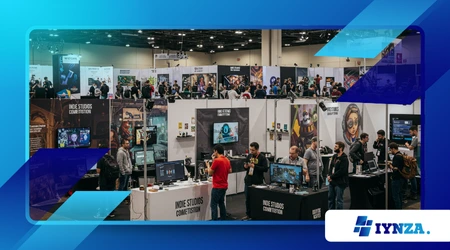How Small Indie Studios Compete with AAA Titles

In an industry dominated by billion-dollar franchises, it might seem impossible for small studios to keep up.
Anúncios
Yet, indie developers continue to surprise the market, producing hits that rival—even outperform—AAA blockbusters. From creative risks to intimate storytelling, these small teams are redefining what success looks like in gaming.
Understanding how indie studios compete with AAA titles is not just a matter of budget versus passion—it’s about strategy, innovation, and connection with players.
This article explores the specific ways indie developers not only survive, but thrive in a space filled with giants. If you’ve ever wondered how a team of five can outshine a studio of five hundred, read on.
Leveraging Creative Freedom to Stand Out
Indie studios aren’t bound by shareholders or corporate marketing agendas. That means they can explore unconventional ideas, mechanics, and worlds without needing mass approval.
Where AAA games often play it safe to appeal to a broad market, indies are free to be weird, raw, and specific. This creative freedom leads to games that feel personal and experimental—traits that resonate with players tired of formulaic blockbusters.
Titles like Undertale, Hollow Knight, and Disco Elysium succeeded not because they had flashy graphics, but because they delivered experiences no major publisher would greenlight. In 2025, that kind of uniqueness is a selling point.
Indie games often break molds because they aren’t trying to fit into them. They invent new genres, reimagine old ones, and offer stories that feel human instead of manufactured. That difference isn’t just artistic—it’s competitive.
Read also: How Indie Developers Are Redefining the Gaming Industry
Building Strong Communities from Day One
Without massive ad budgets, indie studios turn to what they can control: their community. And they do it exceptionally well.
From early-access feedback to transparent dev blogs, indie teams involve players throughout the process. This approach doesn’t just build anticipation—it builds loyalty.
Games like Stardew Valley and Slay the Spire gained traction through word of mouth, YouTube coverage, and grassroots support. By focusing on long-term relationships instead of launch day metrics, these games earned sustained relevance.
Small studios also spend time where their players are: on Discord, Reddit, and Twitter. They respond to feedback personally. They share progress openly. That kind of interaction is rare from AAA devs—and players notice.
Focusing on Depth Over Scale
AAA titles often chase big numbers—hours of content, open-world size, cinematic scope. But bigger isn’t always better.
Indie developers know they can’t compete on size, so they compete on focus. Every mechanic, level, and line of dialogue is crafted with intention. They cut the fluff. They polish the core.
Celeste didn’t offer sprawling environments, but it delivered tight platforming, emotional storytelling, and a perfect difficulty curve. Players remembered that. They talked about it. And they kept coming back.
Depth doesn’t need 100 hours. It needs meaning. That’s a resource indies use better than most AAA teams.
Iterating Fast and Adapting to Feedback
Small teams can pivot quickly. They don’t need to pass changes through endless approval chains. If something isn’t working, they fix it fast.
This agility lets indie games evolve during development in a way AAA titles often can’t. Player feedback can directly shape the final product—even post-launch updates.
Live-balancing, new modes, or even completely reworked systems can happen in days instead of months. In an era where player engagement is king, speed matters.
Vampire Survivors launched in early access with minimal features. But weekly updates—driven by community suggestions—turned it into one of the most addictive hits of the year.
AAA studios plan years in advance. Indie studios react in real time. That responsiveness builds trust.
One Analogy to Remember
Think of AAA studios as cruise ships: massive, powerful, and slow to turn. They have vast crews, established routes, and the ability to carry thousands—but changing direction takes time. Every decision passes through layers of structure, and even small adjustments can take months.
Indie studios, on the other hand, are speedboats. They’re nimble, daring, and fast. A team of three can pivot overnight, test wild ideas, or scrap entire features without bureaucratic resistance.
This agility isn’t a weakness—it’s a competitive edge. While the cruise ship navigates well-traveled waters, the speedboat discovers new islands.
In a creative industry where trends shift fast and player interests evolve quickly, sometimes being smaller means being smarter.
A Statistic That Says It All
According to a 2024 report by Steam Trends, 34 of the top 100 most-played games on the platform were developed by indie studios with fewer than 25 people. In 2015, that number was just 11. That’s a 209% increase over less than a decade.
The same report showed that player engagement with indie titles lasts longer on average, with a higher percentage of completion rates, replayability, and positive reviews. These aren’t flukes. They’re proof that focus and heart can rival—if not exceed—blockbuster budgets.
The indie footprint isn’t just visible. It’s expanding, gaining traction, and changing the definition of what makes a game successful.
A Question Worth Asking
If budget doesn’t guarantee impact, and a team of five can create something unforgettable—what truly defines success in game development?
Is it marketing reach? Photorealism? Studio headcount? Or is it something harder to measure—like emotional connection, community loyalty, and innovation?
As indie games continue to capture players’ attention and challenge industry norms, we have to rethink what it means to “make it.” Because in today’s landscape, success isn’t about scale. It’s about significance.
Conclusion
Indie studios compete with AAA titles not by matching their resources, but by outpacing them in innovation, authenticity, and adaptability.
The result? Games that surprise, inspire, and sometimes even shift the entire industry.
So next time you scroll past a pixel-art game made by two people—remember, it might just be the best thing you play all year.
FAQ – Indie Studios Compete with AAA titles
1. What qualifies a game as “indie”?
Indie games are developed without the financial backing of a major publisher, usually by small teams or individuals.
2. How do indie developers fund their projects?
Through personal savings, crowdfunding, grants, early access revenue, or small publishing deals.
3. Why do some indie games feel more innovative?
Because indie studios can take creative risks without needing mass-market approval.
4. Can indie games compete graphically with AAA titles?
Not usually, but they compensate with strong art direction, unique aesthetics, and immersive sound design.
5. Are indie games generally cheaper?
Yes. Most indie games cost between $10–$30, compared to $60–$70 AAA titles.
6. How do indie games reach players without advertising?
They rely on word of mouth, influencers, streamers, reviews, and direct community engagement.
7. Do indie studios make money?
Many do. Success depends on quality, timing, visibility, and community support.
8. What platforms are best for indie developers?
Steam, itch.io, and the Nintendo Switch are popular, but indie games are growing on all platforms.
9. Can an indie game become a franchise?
Absolutely. Games like Spelunky, Dead Cells, and Shovel Knight have spawned sequels and spin-offs.
10. Are AAA studios influenced by indie games?
Yes. Many AAA titles adopt mechanics, aesthetics, or design philosophies pioneered by indie developers.
